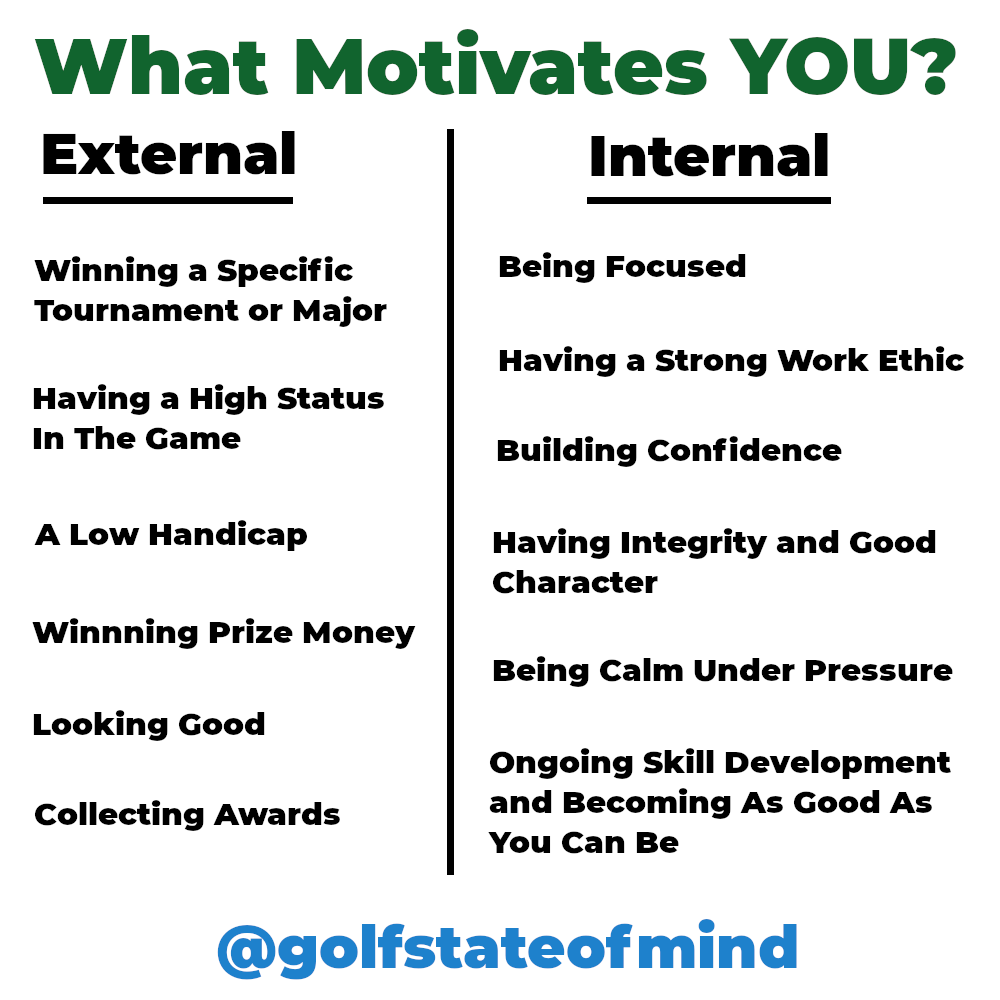The Goal Setting Process For Golf
We’re approaching that time of year again when we reflect on another year passed and prepare for setting fresh goals for our desired success in the new year.
There are several different theories on what the most effective ways are to set goals that increase motivation, effort and the rate of improvement. During the past 10 years that I’ve been a performance and mental coach for golf, I’ve worked with many different personality types (which can affect how effective goal-setting strategies are). This is the goal-setting process that I have found to be most effective for all personality types.
“When I was a young player, I had no visions in my head of fans and trophies. I basically sought 3 things from the game: To improve at it, to compete at it and to win at it.” – Jack Nicklaus
Create A Long Term Vision
Where do you want to go?
Before starting any journey, you need to have a destination in mind. We only get one life, and our time is limited. Every day is precious and gives us the opportunity to create a better life and bring our goals and dreams towards us. But without knowing where you want to go and what you value most, you can easily lose that opportunity. With a long-term goal in mind, it makes you more focused on directing your limited energy towards it each day. Think about what is possible for you and create a vision of it. Make this a “dream” goal that will have you reaching for the stars. Try to avoid making your long-term success about winning one specific tournament, which will add pressure when you play in it. Instead visualize the many successes you will have and the player that you will be when you achieve it.
What is the purpose?
Why do you want to go there?
Although it’s a positive step to create a vision for your future, you need to know why it is that you want that life for yourself. Your long-term success is the accumulation of all the focused effort during each day along the way. What motivates you to put in the effort will have a big effect on whether you achieve your goals and how happy your pursuit of them will make you. You have to love the process more than you do the outcome. Knowing your “why” will also help you weather the tough times on your journey. Ask yourself: “Why will I spend my limited time working hard to pursue this particular endeavor?”
Spend some time establishing your vision and the purpose behind it. This is not the same as goal setting, however it’s an important part of the goal-setting process. Your vision is the destination and the goals are the steps you take to get there.
The Goal-Setting Process: External and Internal Goals
Psychologists tell us that there are two types of goals with different motivations behind them: “external” or “extrinsic” goals and “internal” or “intrinsic” goals. Let’s take a look at some examples:

External goals are called such, because they are not completely with your control (e.g. where you finish in specific tournaments, how you will be perceived by others, how much money you will make or what your ranking will be).
Although your achievement of any goal is uncertain (the future is uncertain for all of us), when you make the performance of others and how others respond to you an additional factor, it can create a lot of pressure, frustration and underperformance along the way. A better way is to make your success about how well you do at achieving your “internal” goals and letting your success ensue.
“Don't aim at success. The more you aim at it and make it a target, the more you are going to miss it. For success, like happiness, cannot be pursued; it must ensue…you have to let it happen by not caring about it.” - Viktor Frankl, Holocaust Survivor and Psychotherapist
Internal goals are more within your control (i.e. the things you do daily or “the process”). They are based solely on what you choose to do with your time and the effort you put into it, irrespective of the result you ultimately get or where you finish against others. Your measure of success is by your own standards, and hence you have a much higher degree of control over whether you achieve success or not. Success is measured more by the “process” (the activities and tasks which develop skills and shape behaviors) and your effort level. An example of an internal goal would be to “play in 5 tournaments this season,” or “spend 5 hours per week on my short game.” That goal is achieved when that player plays in 5 tournaments or spends 5 hours on their short game whatever the outcome, so the success is completely within their control.
I’m not going to make a blanket statement and say that you should set only internal goals. External goals can be motivating for some personality types (very competitive people) but generally speaking, studies suggest that goals that are more internal and about your ongoing personal development are more motivating, more durable and lead to higher performance and happiness in the long-run.
Combining internal goals with “performance goals”
Making it a goal to spend 5 hours per week on your short game might not push a player enough. It can be more effective to add what are called “performance goals” to the internal goal. A performance goal is a statistic that would represent the improvement the player is trying to make. For example: If a player knows that their short game is the weakest area of their game (they only get up and down 25 percent of the time from within 20 yards of the green), they might set the goal to improve this number to 40 percent. For some personality types adding a deadline can increase motivation and urgency. Do “performance tests” in your practice sessions to see where you are in relation to that goal (you’ll also be able to gather data from your rounds). Being able to measure progress is an important part of the goal setting process - seeing that you are improving can increase motivation and effort further and also tell you if what you are doing to improve a skill is working.
On a personal note, over the past year I’ve found a new passion in running. Although I love just getting out there and doing it, I'd like to become as fit as possible. For that reason, my internal goal of running at least 4 times per week isn’t enough. I know what my personal best times are and during each run I try to run faster and improve on those times. Seeing that I’m getting fitter week by week pushes me harder.
Next steps: Self-reflection
Think about (and write down) your long- and short-term vision and what it is that truly motivates you to put effort into achieving it. How will becoming a champion golfer give your life more meaning? What will it represent? How will it look and feel?
Next, think about what it could be that could get in the way of that goal? How will you overcome this? By doing this, you start to figure out solutions to the challenges along the way.
Game analysis and tangible goals
In what areas are you currently lacking the most when you think about the player you want to be in the future? What behaviors and skills do you need to change/improve?
Do an overall analysis of your game and assess yourself in the 3 main areas of the game: technical, mental and physical skills. Decide where you’d like to be and set realistic weekly process goals for these 3 areas that don’t refer to the outcome (e.g., meditate for 10 mins 3 times per week or do 3 hours of short game performance practice). If you feel that a performance goal would be beneficial, then add one (e.g. to be able to get up and down a certain percentage of the time within 8 weeks).
Post these goals somewhere where they’ll be clearly visible; there’s no point setting goals that get quickly forgotten about because you don’t remind yourself of them. Keep a performance journal and put a check mark next to each goal achieved each week.
Visualize the outcome and the process
Make it a goal to visualize your “vision” at least a few times per week. When you see it over and over again in your mind, it will lead to greater self-belief and less self-doubt which makes you do everything with more effort and determination.
In addition to visualizing you reaching your dream goals and becoming the player/person you want to be, visualize the process too. Studies show that people who visualize what they will have to do (process simulation) in addition to visualizing their dream goals, achieve more success than those people who only visualize the desired outcome.
Thanks for reading. I hope the new year is a healthy and productive one for you and that you use this goal setting process to use your time as effectively as possible to take you closer to your dreams and best version of yourself.
Do you set internal or external goals, or a blend? Which do you find more effective? Please let me know on social media @golfstateofmind.

